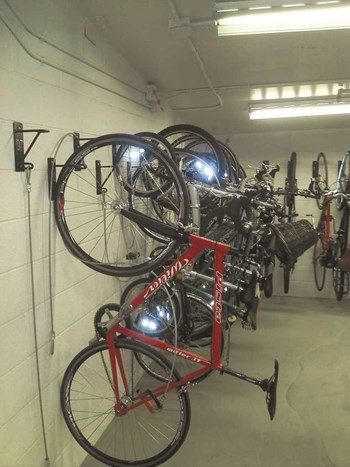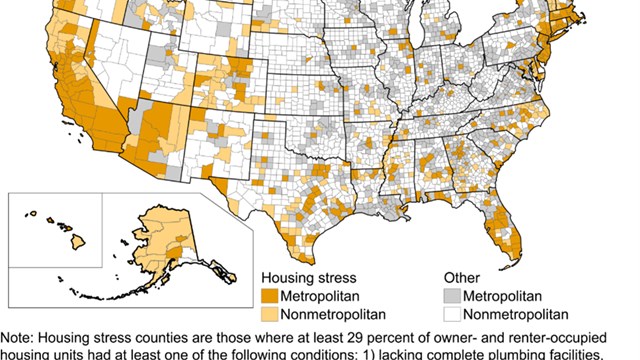
With the price of gasoline rising, daily traffic snarls, a desire to live a healthier life and the responsibility to lessen the effect of one's carbon footprint, there are many reasons to own a bike. Buying the bike is just the beginning. Bicycles today are not cheap—some can cost more than the price of a used car, which brings to mind the security of our valuable two-wheelers. In a residential development other issues arise such as the wear-and-tear on the building. Even if a small percentage of residents in a complex have a bicycle...those bikes comings and goings will bear there mark on the floors, the interior of the elevators and the hallway walls.
On the surface, owning a bicycle may not seem like a complex subject, but when issues are examined the long term effects of residential bicycle ownership is reviewed, it can turn into a major headache, and a big bone of contention for managers.
Consider, for instance, recent comments to a bicyclist’s blog query about storage; responses range from the practical to the whimsical:
• “Hang the front tire over the patio rail.”
• “One hundred percent ‘no’ to bike storage areas. You can just kiss your bike goodbye if you store it there.”
• “They’re at the foot of my bed … My bikes are the last thing I see when I go to bed and the first thing I see when I wake up.”
• “A big selling point for our apartment was the tile floors and cinder block walls. The walls are kinda ugly, but no bike is going to hurt them, and the dirt wipes off easy.”
• “Fill the tires with helium and let them float to the roof.”
A lot of opinions there, on a hot topic. Basically, bicycling is big in the Big Apple—especially during the prolonged warm seasons of late—and savvy property managers, developers and boards are including storage convenience among their benefits.
Bicycling is big in New York City and will continue to grow exponentially in the years ahead. New Yorkers love riding their bikes, as a means of commute, exercise, and especially for fun when the cold winter winds subside and the city's denizens want to escape their winter hibernation. New Yorkers are fortunate to live in one of the best biking cities in the U.S. In fact in 2012, Bicycling Magazine ranked New York City as the seventh best bicycling city in the nation. According to the magazine, the future of biking in the city is exciting.
In 2013 New York's Citi-Bike will be launched. It was supposed to be launched this past summer, but was delayed due to a software glitch. When the program is implemented it will be the largest bike-share system in the nation, with 600 stations and 10,000 bikes, primarily spread throughout Manhattan and Brooklyn. Additionally, New York City's Department of Transportation (DOT) is planning to expand bike-lane miles to 1,800 miles by the year 2030. This expansion will put the city in league with other legendary cycling cities such as Paris. This is a commitment that local bike advocates refer to as “staggering.”
A survey conducted by the city in 2009 found that more than half a million New Yorkers are regular bicycle riders, hopping on their bikes several times per month. According to the DOT, the number of New Yorkers who commute to work by bicycle more than doubled from 2006 to 2012, and grew by 13 percent from 2009 to 2010.
The Bloomberg administration has been seeking ways to make the city more hospitable to bicycles. Since 2007, the city has carved out 259 miles of bike lanes and protected routes in the five boroughs. Some real estate brokers say as many as half their clients now ask about bike storage, and though few buyers consider it a deal-breaker, marketing materials now make the most of bike rooms and proximity to bikable parks.
The Need for Storage
At a building marketed and managed by Halstead Property, +Art, at 540 West 28th Street just off the High Line, a room off the lobby was to be used for cold storage, to hold deliveries from companies like Fresh Direct until residents returned home. But it is now being converted into a bike room. The grocery-holding room was moved to a reconfigured space in the basement.
“We started seeing high demand for bike storage about 18 months ago,” said Stephen G. Kliegerman, the president for development marketing at Halstead. “It's an amenity I think people are starting to expect in a new building.”
Superior Ink, a Related Companies condominium on West 12th Street, even offers bike valet service. Residents can call ahead and ask that their bikes be taken to the lobby.
But white gloves or no, bike storage tends to be easier to find in new buildings. As of 2009 most new buildings, including multifamily residential, have been required by the city to provide some bike storage. (Offering it is also a relatively inexpensive way for a developer to gain points toward LEED certification, which measures a building's environmental impact.)
“It adds to the general tone of the building,” said Shaun Osher, the founder of the brokerage firm CORE, who kept his rusty bike on the fire escape when he first moved to the city 20 years ago, “It's one less thing you have to worry about in your apartment.”
The developers of 80 Metropolitan, a condo development in Williamsburg that opened in 2009 and is being marketed by Halstead, originally set aside 24 spaces for bicycles, all free. When those filled, they added 42 more. When those were taken, the developer installed a hanging system in the garage for 22 more bikes. Now, there is a plan to add enough storage to accommodate the 12 cyclists on the current waiting list.
What's the Plan?
This example illustrates how planning for bicycle storage is becoming a necessity. What do property managers and boards need to know when planning storage areas, and what rules need to enacted to prevent problems?
According to Erin Michaels, a board member at 305 West 97th Street, a medium-sized condo building on the Upper West Side, “We thought long and hard about what house rules we needed to enact before opening our storage facilities.”
While storage rules should be adjusted to a site's physical limitations and allowances, this is a sample guideline for boards—a typical arrangement, set up by the directors at 305 West 97th Street, a medium-sized condo building on the Upper West Side which boasts two locked bike storage facilities:
1.All bicycles must be registered with the Management Office.
2. Bicycle storage spaces are available to residents only. Resident owners have the right of first refusal regarding bike storage availability.
3.All bikes must enter and exit through the service entrance and must be locked and stored only in the racks provided.
4. Monthly fees for bicycle(s) must be paid on time each month, failure to pay may result in the loss of the storage space.
5.Bicycles are not permitted in the lobby, on passenger elevators, or in any of the resident hallways.
6.Neither Management nor the Condominium Association assumes responsibility for the loss, theft or damage to any bicycle.
7. If the sale of a unit or termination of a residential lease results in an individual moving out of the building, the bicycle space reverts to the association for reassignment.
8.Failure to comply with the bicycle storage rules or to pay the associated fees shall be sufficient cause for the 305 West 97th Street Board of Directors and Management to revoke bicycle storage privileges.
What Does It Take ?
It may seem like a very simple idea, just take an unused portion of the basement; fence it in; put a padlock on it; give a copy of the keys to bike owners and—instant bike storage.
“We didn't want residents just putting their bikes anywhere in the basement, that would lead to problems and inevitably to a situation where one bike owner is accusing another bike owner of damage. We decided to go with a specially built bike storage rack system,” Michaels explained.
One company that specializes in constructing bike storage systems is Rudy Rack. Rudy Rack was started in 1991 when its founder Dick “Rudy” Rhudenbusch recognized that bike retailers needed quality, versatile and efficient bike storage systems. Since then Rudy Rack has expanded their storage rack line to include specially constructed racks for condominiums.
According to Rudy Rack, “A well-designed racking structure can help organize storage space and make it easier for tenants to access their velocipedes.”
Rudy Rack manufactures four different types of racks. A stand-up rack system; a double-decker rack system which maximizes storage in small spaces; a wall rack system and a backroom storage unit on wheels for temporary storage solutions. All of these storage systems can be seen on their website at www.RudyRack.com.
Bicycle Storage Bottom Line
Providing bike storage has also presented some boards with a new income opportunity. The Beatrice and the Continental, both on Avenue of the Americas, charge upwards of $100 per month, according to Clifford Finn of Citi Habitats Marketing Group, the exclusive brokerage for the two properties. “Retail and commercial space is at a premium,” Finn explained of that neighborhood. “There's not a lot of leftover space in a place like that.”
In most buildings however, either the service is free or nominal, maybe $10 a month. That small sum is mostly intended to discourage the leaving of unused and unusable bikes in storage ad infinitum, rather than to raise revenue.
“While some boards do charge high storage fees, we don't,” says Michaels. “It's just a nice thing to be able to give our residents. We only charge a minimal amount...to pay for the cost of the storage racks, and cover the cost of electricity and maintenance of the bike storage facilities. It's a lot cheaper for us to provide the storage than to repaint hallway walls that get scuffed by handlebars and tires, or clean the bike trafficked carpets. It's a win-win for everyone.”
When it comes to common areas, management has to define what is acceptable—and what is not—when it comes to bicycle storage. It's a challenge that seems to be growing with each passing year, as the interest, and the list that makes bicycling a good idea grows.
J.M. Wilson is a freelance writer and a frequent contributor to The Cooperator. Associate Editor Liam P. Cusack contributed to this article.






Leave a Comment